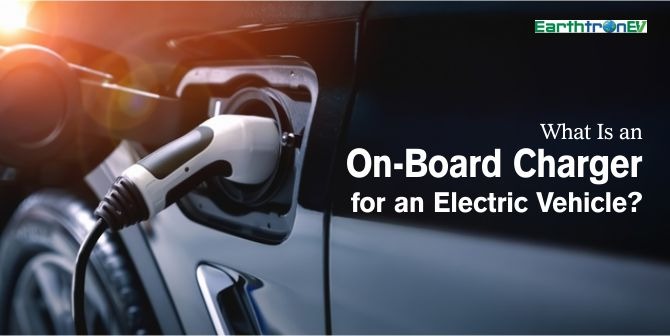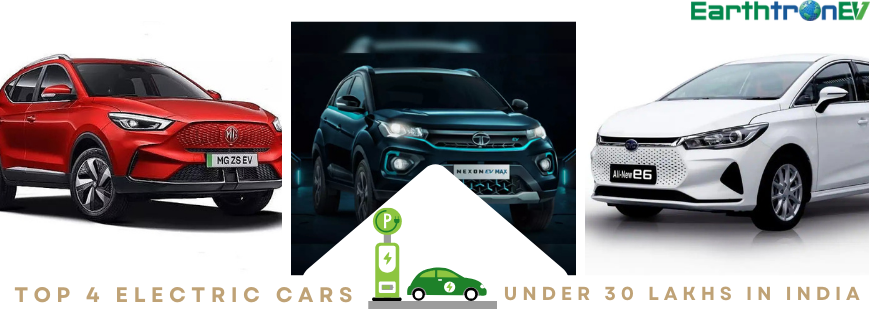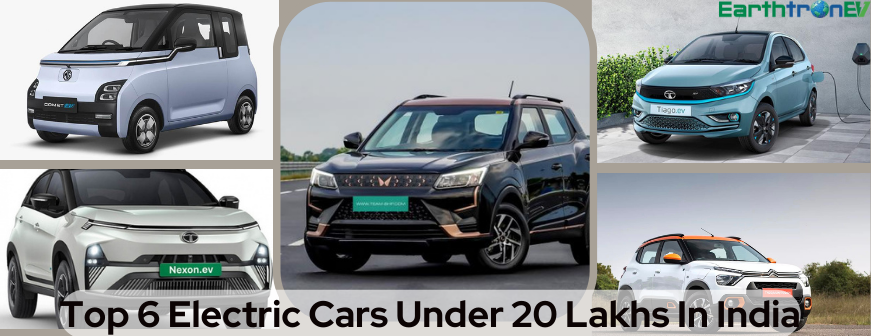Electric vehicle charging depends on a charger which directly implies the charging speed and efficiency of the EV batteries. Four components in the electric vehicle industry decide the competence and charging speed. These components are a charging cable, a charging station, an on-board charger, and the weakest link of the charging chain. Among these charging aspects, the on-board chargers are the least known components that convert AC power to DC power. This EV article discusses what on-board chargers are, their benefits, workings, types, etc.
What are on-board chargers?
The term chargers are charging equipment that connects the electric vehicles to the charging point or source of charging to recharge the EVs. These chargers can be of two types, which are namely: on-board chargers and charging station chargers (either AC or DC). The on-board chargers (OBC) are power electronics devices that convert AC power from any AC source into DC power.
These AC sources can be residential outlets. It follows this conversion mechanism to charge the EV’s battery pack. Using the OBC chargers, the charging points at the charging station communicate with the vehicle controllers to specify the appropriate amount of current or power supplied to the vehicles. It also determines whether the correct charging standard is suited to electric vehicles.
Several charging standards are available to EV users all over the map. These include regional standards for North America, Europe, and China. On-board systems are engaging for electric vehicle owners since they provide the scalability and flexibility to recharge and discharge electric vehicles wherever the charging power outlet is open.
Further, on-board chargers are automatically adjustable to the exact regional standards depending on data obtained from the electric vehicle supply equipment (EVSE) controller or vehicle controller. Additionally, on-board systems maintain correct voltage matching for the electric vehicle battery. Experts in EV manufacturers precisely designed the on-board charging systems for all-electric vehicles to undergo a particular voltage requirement of the battery and the grid.
During the manufacture of electric vehicles with OBC systems, manufacturers minimize the weight of ob-board chargers because the OBC is permanently mounted. Doing this can decrease the consequence on the range of the EVs. The on-board charger plays a vital role in bidirectional charging methods.
It means OBCs can also transform DC power from the high-voltage battery pack to AC power, supporting grid power (V2G), AC loads (V2L), and different EVs.
Benefits of using On-board chargers (OBCs)
Following are some benefits of using an on-board charger for EV charging –
- An on-board charger allows EV users to regulate the current and voltage according to the requirement of the electric vehicle battery. It thus takes care of the lifespan of the EV batteries controlling the voltage or Current Control Mode.
- The OBC provides either persistent current or steady voltage charging. These ease the charging operation of the EVs.
- The on-board chargers secure that EV users are charging their vehicles at a constant current. Therefore, it maintains speed and efficiency, changing to stable voltage charging; when the voltage at both ends of the battery goes to specific amplitude. OBC thus enables the efficient and fast charging system called the charging strategy, which is the most critical aspect of the on-board charger.
- One of the significant benefits of the OBC is it operates readily-available AC power. Thus installing an extension lead, EV users can plug their vehicle into any of the billions of outlets established in each building or charging station.
The Working of an On-board charger
While charging with on-board chargers, there are two types of charging systems, AC or DC power. The on-board charger‘s operating rectifier converts the high-power AC input into DC power. It thus provides Power Factor Correction. The power factor correction (PFC) circuit cuts the harmonic warping in the supply current to increase the power factor to unity.
Thus, OBC provides a current waveform; comparable to a general “sine wave.” This component of this EV charger decides whether it can use one, two, or all of the alternating current phases. Another critical role of the DC-to-DC converter of OBC must isolate the power grid from the HV DC bus and the HV DC bus from the LV dc bus to ensure preventive and protective measures.
The second stage of the on-board chargers takes the 700 volts output voltage and then chops the resultant DC signal into a square wave that operates a transformer. It then delivers the needed DC voltage. With this system, EV users often use an isolated CAN bus to monitor and regulate the complete charging system. EV users can also use Digital isolators and integrated DC/DC power converting to isolate the CAN bus. Lastly, the OBC system supplies the required voltage to the electric vehicle battery.
How many types of OBC are there?
Based on the number of phases and the output, we can divide the on-board chargers into two categories, single-phase and three-phase. The standard single-phase OBC has the span to take the power of 7.2 kilowatts to 11 kilowatts. On the other hand, a three-phase OBC has a power of 22 kilowatts. Depending on these capabilities decide the charging time of the electric vehicle’s batteries which is the primary factor.
Critical Factors for Installing the On-board chargers
Before installing the OBC system, installers or manufacturers must consider the following factors –
- Charging time
- Adequate Temperature, cooling, and efficient utilization of space
- The ultimate power the battery pack can resist
- Power Factor Correction (PFC) and rectifying the AC signal
- Protective isolation between the power source and electric vehicle battery
- The AC input and the needed output level
- Communication between the electric vehicle and electric vehicle supply equipment
Challenges meet using On-board chargers
Following are some challenges faced using on-board chargers:
Design challenges
Manufacturers designing the power system meet several challenges, such as high-efficiency requirements in a little space. The problem is especially authentic in the case of OBCs. But to manage the efficiency of the OBC, manufacturers must specifically note this problem and overcome it to reduce charging time.
Environmental Challenge
Manufacturers undergoing the designing of an automotive application have to take into account the intense environment of the vehicle. So, OBC power system manufacturers must create designs that manage long-lasting heat effect, vibration, cold and substantial amounts of conducted and radiated electrical noise.
The challenge to reducing heat generation
Designing the OBC power systems brings constant challenges that involve generating less waste during charging. The more efficient, the less will generate the waste heat. It diminishes the need for thermal management. Manufacturers often need to install additional heat sinks to an OBC design to bring such efficiencies.
It increases the size and weight of the power system. But unfortunately, neither of these is adequate within the limited spaces of a modern car. It will decrease the efficiency of the vehicle by increasing the weight of the electric vehicle.
Challenges with Regulatory Compliance
Regulatory compliance is another critical challenge with OBCs. It mandates meeting the power factor rules for the grid when the electric vehicle users plug in the vehicle for charging. Designers typically use a boost converter for power factor correction (PFC) to fix the challenge with the AC input, delivering a high-level DC voltage to a DC-DC converter, which the charging system includes to charge the electric vehicle batteries.
Conclusion
On-board chargers are and will always remain one of the most critical aspects of electric vehicle charging. On-board chargers are efficient in charging and also small and lightweight. But with all these advantages, OBC designers meet several challenges while designing OBCs. To meet the aggressive demands of the OBC chargers in the EV industry, manufacturers must cope with these rigorous challenges and flourish in the electric vehicle industry.






